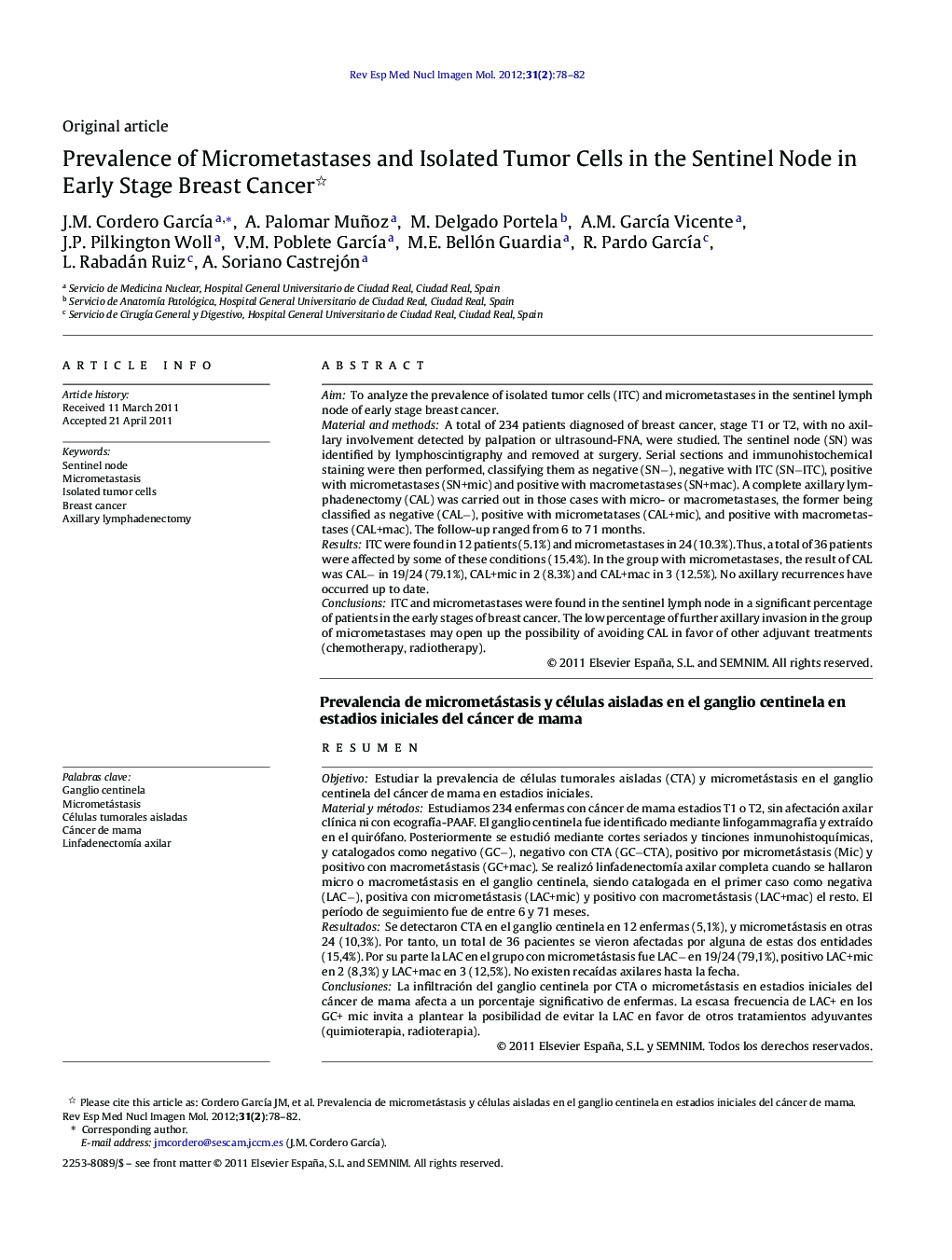| کد مقاله | کد نشریه | سال انتشار | مقاله انگلیسی | نسخه تمام متن |
|---|---|---|---|---|
| 4250748 | 1283921 | 2012 | 5 صفحه PDF | دانلود رایگان |

AimTo analyze the prevalence of isolated tumor cells (ITC) and micrometastases in the sentinel lymph node of early stage breast cancer.Material and methodsA total of 234 patients diagnosed of breast cancer, stage T1 or T2, with no axillary involvement detected by palpation or ultrasound-FNA, were studied. The sentinel node (SN) was identified by lymphoscintigraphy and removed at surgery. Serial sections and immunohistochemical staining were then performed, classifying them as negative (SN−), negative with ITC (SN−ITC), positive with micrometastases (SN+mic) and positive with macrometastases (SN+mac). A complete axillary lymphadenectomy (CAL) was carried out in those cases with micro- or macrometastases, the former being classified as negative (CAL−), positive with micrometatases (CAL+mic), and positive with macrometastases (CAL+mac). The follow-up ranged from 6 to 71 months.ResultsITC were found in 12 patients (5.1%) and micrometastases in 24 (10.3%). Thus, a total of 36 patients were affected by some of these conditions (15.4%). In the group with micrometastases, the result of CAL was CAL− in 19/24 (79.1%), CAL+mic in 2 (8.3%) and CAL+mac in 3 (12.5%). No axillary recurrences have occurred up to date.ConclusionsITC and micrometastases were found in the sentinel lymph node in a significant percentage of patients in the early stages of breast cancer. The low percentage of further axillary invasion in the group of micrometastases may open up the possibility of avoiding CAL in favor of other adjuvant treatments (chemotherapy, radiotherapy).
ResumenObjetivoEstudiar la prevalencia de células tumorales aisladas (CTA) y micrometástasis en el ganglio centinela del cáncer de mama en estadios iniciales.Material y métodosEstudiamos 234 enfermas con cáncer de mama estadios T1 o T2, sin afectación axilar clínica ni con ecografía-PAAF. El ganglio centinela fue identificado mediante linfogammagrafía y extraído en el quirófano. Posteriormente se estudió mediante cortes seriados y tinciones inmunohistoquímicas, y catalogados como negativo (GC−), negativo con CTA (GC−CTA), positivo por micrometástasis (Mic) y positivo con macrometástasis (GC+mac). Se realizó linfadenectomía axilar completa cuando se hallaron micro o macrometástasis en el ganglio centinela, siendo catalogada en el primer caso como negativa (LAC−), positiva con micrometástasis (LAC+mic) y positivo con macrometástasis (LAC+mac) el resto. El período de seguimiento fue de entre 6 y 71 meses.ResultadosSe detectaron CTA en el ganglio centinela en 12 enfermas (5,1%), y micrometástasis en otras 24 (10,3%). Por tanto, un total de 36 pacientes se vieron afectadas por alguna de estas dos entidades (15,4%). Por su parte la LAC en el grupo con micrometástasis fue LAC− en 19/24 (79,1%), positivo LAC+mic en 2 (8,3%) y LAC+mac en 3 (12,5%). No existen recaídas axilares hasta la fecha.ConclusionesLa infiltración del ganglio centinela por CTA o micrometástasis en estadios iniciales del cáncer de mama afecta a un porcentaje significativo de enfermas. La escasa frecuencia de LAC+ en los GC+ mic invita a plantear la posibilidad de evitar la LAC en favor de otros tratamientos adyuvantes (quimioterapia, radioterapia).
Journal: Revista Española de Medicina Nuclear e Imagen Molecular (English Edition) - Volume 31, Issue 2, March–April 2012, Pages 78–82